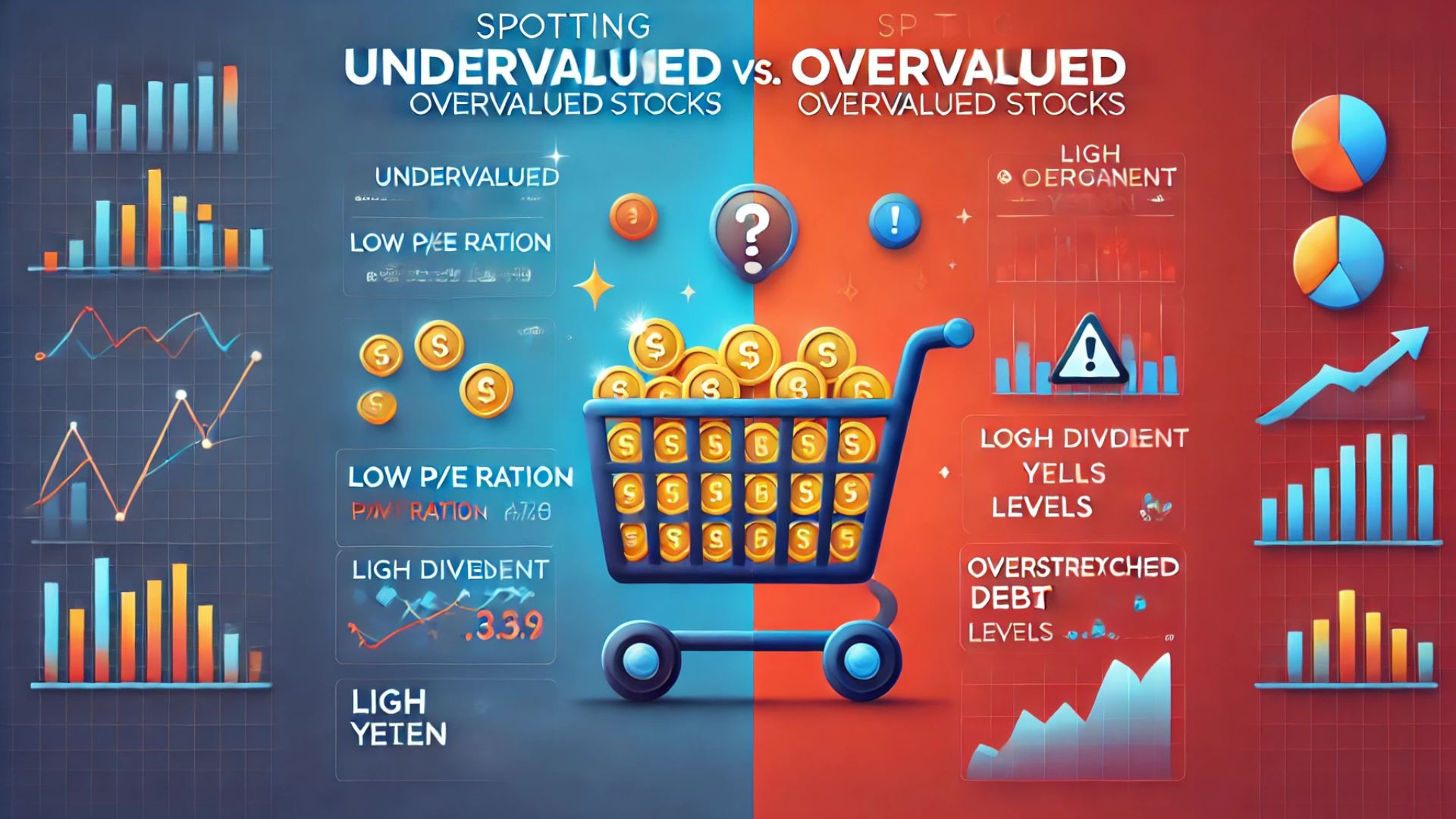
Ever wonder if the stocks in your portfolio are truly worth their price? Identifying undervalued and overvalued stocks can help you make better investment decisions and maximize your returns. The Indian stock market offers a range of opportunities, but knowing which stocks are bargains and which are overpriced is key to success. Let’s dive into how you can spot these stocks without getting lost in complicated financial jargon.
Understanding Undervalued and Overvalued Stocks
Before we jump into the strategies, it’s essential to understand what undervalued and overvalued stocks mean.
Undervalued Stocks: These are stocks that are trading below their intrinsic value, meaning their market price is less than what they’re actually worth. Think of it like finding a designer outfit on sale—you’re getting more value for less money. Investors love undervalued stocks because they have the potential to increase in price, offering a good return on investment.
Overvalued Stocks: On the flip side, overvalued stocks are trading above their intrinsic value. Imagine paying a premium price for something that’s not worth it. These stocks might have risen due to hype or short-term factors, but they’re often at risk of price drops in the future.
Why Identifying Stock Value Matters
Investing in undervalued stocks gives you a chance to buy low and sell high. Conversely, avoiding overvalued stocks prevents you from paying too much for something that might not hold its value. In short, understanding stock valuation helps you make informed decisions and manage risk more effectively.
Key Indicators to Identify Undervalued Stocks
1. Price-to-Earnings (P/E) Ratio
The P/E ratio is one of the simplest and most widely used metrics to identify undervalued stocks. It’s calculated by dividing the current share price by the earnings per share (EPS).
- Low P/E Ratio: Generally indicates that a stock is undervalued. However, this isn’t always the case, so consider the P/E ratio in context with other factors.
- Comparison: Compare the P/E ratio of a stock with the industry average or the P/E ratio of similar companies. If it’s significantly lower, the stock might be undervalued.
2. Price-to-Book (P/B) Ratio
The P/B ratio compares a company’s market value with its book value (total assets minus liabilities).
- Low P/B Ratio: A P/B ratio below 1 can suggest that the stock is undervalued, meaning you’re paying less for the company’s assets than their actual worth.
- Industry Context: Just like the P/E ratio, compare the P/B ratio to the industry average to get a clearer picture.
3. Dividend Yield
Dividend yield is another important metric, especially for investors who value steady income.
- High Dividend Yield: A higher yield might indicate that a stock is undervalued, particularly if the company has a strong track record of paying dividends. However, a super-high dividend yield could be a red flag for financial instability, so be cautious.
4. Debt-to-Equity Ratio
This ratio measures a company’s financial leverage by comparing its total liabilities to shareholders’ equity.
- Low Debt-to-Equity Ratio: A lower ratio suggests that the company isn’t overly reliant on debt to finance its operations, which can be a good sign for long-term stability and undervaluation.
Strategies to Spot Overvalued Stocks
1. Sky-High P/E Ratio
While a low P/E ratio can indicate undervaluation, an excessively high P/E ratio might be a sign of overvaluation.
- Market Hype: Sometimes, stocks with high P/E ratios are driven by market hype rather than solid fundamentals. Be cautious with stocks that seem overpriced compared to their earnings.
2. Low or No Dividend Yield
Companies that don’t pay dividends or have a very low dividend yield might be overvalued, especially if they are mature companies with stable cash flows.
- Growth vs. Value: While some growth companies reinvest profits instead of paying dividends, a lack of dividends in a mature company could signal overvaluation.
3. Overstretched Debt Levels
If a company has a high debt-to-equity ratio, it might be overleveraged, making it vulnerable to economic downturns.
- Risk of Default: Companies with too much debt are at risk of defaulting, and their stocks can be considered overvalued if the market hasn’t priced in this risk.
4. Recent Price Surge
A sudden and significant rise in a stock’s price could indicate overvaluation, especially if there hasn’t been a corresponding improvement in the company’s fundamentals.
- Temporary Factors: Price surges might be due to temporary factors like news events or market speculation. Be wary of chasing stocks that have rapidly increased in price without clear reasons.
Practical Steps for Indian Investors
Now that you know the key indicators, here’s how you can apply them specifically to the Indian stock market:
- Research: Use financial websites like Moneycontrol, Economic Times, or NSE India to get up-to-date data on P/E ratios, P/B ratios, and dividend yields.
- Compare: Always compare the ratios of a company to its industry peers in India. For example, if you’re analyzing a banking stock, compare it with other banks, not with a tech company.
- Keep an Eye on the Economy: The Indian economy has its own unique factors, like government policies and inflation rates. These can affect the valuation of stocks differently than in other markets.
- Use Analyst Reports: Many Indian brokerage firms offer detailed analyst reports that can help you gauge whether a stock is undervalued or overvalued. Take advantage of these resources.
- Stay Patient: Don’t rush into buying a stock just because it looks undervalued. Sometimes, stocks remain undervalued for a reason, such as underlying issues in the company or sector. Do your homework!
How to Buy and Sell Stocks in the Indian Market
FAQs
Q: What is the best time to buy undervalued stocks?
A: The best time to buy undervalued stocks is when the broader market is experiencing a downturn, but the company’s fundamentals remain strong. This often happens during economic slowdowns or market corrections.
Q: Can a stock be both undervalued and risky?
A: Yes, some undervalued stocks are cheap for a reason—they might belong to companies with declining revenues, high debt, or other financial problems. Always assess the risks before investing.
Q: How often should I evaluate my stock portfolio?
A: It’s a good idea to review your portfolio at least once every quarter. However, if there are significant changes in the market or in the specific companies you’ve invested in, you might need to reassess more frequently.
Wrapping Up
Identifying undervalued and overvalued stocks in the Indian stock market isn’t rocket science, but it does require some diligence and understanding of key financial metrics. By focusing on P/E ratios, P/B ratios, dividend yields, and debt levels, you can make more informed investment decisions. Always remember to compare stocks within the same industry and consider the broader economic context.
By mastering these strategies, you’ll be well on your way to building a smarter, more profitable portfolio.

